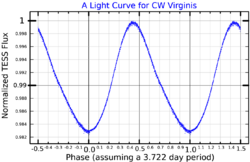Astronomy:78 Virginis
| Observation data Equinox J2000.0]] (ICRS) | |
|---|---|
| Constellation | Virgo |
| Right ascension | 13h 34m 07.93186s[2] |
| Declination | +03° 39′ 32.2738″[2] |
| Apparent magnitude (V) | 4.92[3] |
| Characteristics | |
| Spectral type | ApEuCrSr[4] |
| B−V color index | 0.029±0.016[3] |
| Variable type | α2 CVn[5] |
| Astrometry | |
| Radial velocity (Rv) | −9.7±0.3[3] km/s |
| Proper motion (μ) | RA: +45.51[2] mas/yr Dec.: −24.70[2] mas/yr |
| Parallax (π) | 17.65 ± 0.20[2] mas |
| Distance | 185 ± 2 ly (56.7 ± 0.6 pc) |
| Absolute magnitude (MV) | 1.15[3] |
| Details[6] | |
| Mass | 2.16±0.04 M☉ |
| Radius | 2.11±0.04 R☉ |
| Luminosity | 27±2 L☉ |
| Temperature | 9,100±190 K |
| Rotational velocity (v sin i) | 29±4 km/s |
| Age | 435±55 Myr |
| Other designations | |
| Database references | |
| SIMBAD | data |
78 Virginis is a variable star in the zodiac constellation of Virgo, located 175 light-years from the Sun. It has the variable star designation CW Virginis and the Bayer designation o Virginis; 78 Virginis is the Flamsteed designation. This object is visible to the naked eye as a faint, white-hued star with an apparent visual magnitude of 4.92. It is moving closer to the Earth with a heliocentric radial velocity of −10 km/s.[3]
This is an Ap star with a stellar classification of ApEuCrSr,[4] displaying strong lines of strontium, chromium, and other iron peak elements.[6] It is classified as an Alpha2 Canum Venaticorum variable, ranging in magnitude from 4.91 down to 4.99 with a period of 3.722 days.[5] 78 Virginis is the first star other than the Sun to have a magnetic field detected; it displays a dipole structure with a surface intensity of around 3.3 kG. It is a candidate rapidly oscillating Ap (roAp) star. This star is 435 million years old with 2.16 times the mass of the Sun and 2.11 times the Sun's radius. It is radiating 27 times the Sun's luminosity from its photosphere at an effective temperature of 9,100 K.[6]
References
- ↑ "MAST: Barbara A. Mikulski Archive for Space Telescopes". Space Telescope Science Institute. https://mast.stsci.edu/portal/Mashup/Clients/Mast/Portal.html.
- ↑ 2.0 2.1 2.2 2.3 2.4 van Leeuwen, F. (2007), "Validation of the new Hipparcos reduction", Astronomy and Astrophysics 474 (2): 653–664, doi:10.1051/0004-6361:20078357, Bibcode: 2007A&A...474..653V.
- ↑ 3.0 3.1 3.2 3.3 3.4 Anderson, E.; Francis, Ch. (2012), "XHIP: An extended hipparcos compilation", Astronomy Letters 38 (5): 331, doi:10.1134/S1063773712050015, Bibcode: 2012AstL...38..331A.
- ↑ 4.0 4.1 Houk, N.; Swift, C. (1999). "Michigan catalogue of two-dimensional spectral types for the HD Stars". Michigan Spectral Survey (Ann Arbor, Michigan: Department of Astronomy, University of Michigan) 5. Bibcode: 1999MSS...C05....0H.
- ↑ 5.0 5.1 Samus, N. N. et al. (2017), "General Catalogue of Variable Stars", Astronomy Reports, 5.1 61 (1): 80–88, doi:10.1134/S1063772917010085, Bibcode: 2017ARep...61...80S.
- ↑ 6.0 6.1 6.2 Perraut, K. et al. (July 2015). "The fundamental parameters of the Ap star 78 Virginis. Could 78 Vir be a rapidly oscillating Ap star?". Astronomy and Astrophysics 579: 7. doi:10.1051/0004-6361/201526163. A85. Bibcode: 2015A&A...579A..85P.
- ↑ "78 Vir". SIMBAD. Centre de données astronomiques de Strasbourg. http://simbad.u-strasbg.fr/simbad/sim-basic?Ident=78+Vir.
 |


